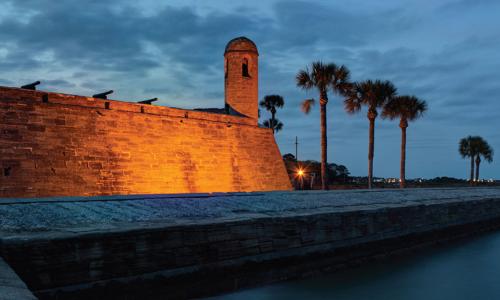This profile is excerpted from the 2014 report, "National Landmarks at Risk: How Rising Seas, Floods, and Wildfires Are Threatening the United States' Most Cherished Historic Sites."
The Statue of Liberty and Ellis Island, prominently positioned in New York Harbor and serving as a gateway to our nation’s largest city, are powerful symbols of freedom and democracy. Each year, millions of tourists visit these monuments to trace their family ancestry or explore the immigration experience so central to the US identity.
Those visits came to a halt on October 29, 2012, when Hurricane Sandy submerged most of Liberty and Ellis islands, destroying vital operating systems and causing an estimated $77 million in damage. It took many months of recovery efforts before they reopened to the public in 2013. Even then, repairs were still under way to protect Ellis Island from future storms, whose surge of piled-up water will be magnified by rising seas.
Nearly 14 million immigrants entered the United States through New York between 1886 and 1924. The Statue of Liberty with its raised torch, famously called “The Mother of Exiles,” welcomed them as they sailed into port. The vast majority of newcomers were processed at nearby Ellis Island, which was the country’s largest immigration station. Until 1954, when it officially closed, 12 million immigrants stepped onto US soil for the first time at Ellis Island. For most of these new arrivals, the island marked the beginning of a new life in the United States, one filled with the promise of economic opportunity and freedom from persecution.
But while Liberty Island (upon which the Statue of Liberty stands) and Ellis Island have long represented a safe refuge for generations of immigrants, the islands themselves were not protected from the ravages of Hurricane Sandy. A massive storm unlike any experienced before in New York, together with rising sea levels primarily due to climate change, caused floodwaters to inundate three-quarters of Liberty Island and almost all of Ellis Island.
Liberty Island was closed for more than eight months and Ellis Island partially reopened a full year after the storm, with sections of the historic main building and museum, including most of their exhibits, remaining closed. Statue Cruises, the company that runs ferries to the two islands as well as harbor tours, saw its annual ridership of nearly 4 million drop by more than half, lost 80 percent of its overall revenue, and had to lay off 75 percent of its workforce during the closures.
Hurricane Sandy also marked the end of a 200-year tradition of people living on Liberty Island. The National Park Service (NPS) decided not to rebuild the small brick house located on the lowest part of the island—home to the park’s superintendent—because of the danger of placing residents in the path of future flooding.
Previous coastal storms have hit New York with higher winds and more rain than did Hurricane Sandy, but the storm surge it created was unprecedented. Sandy coincided with a higher-than-normal high tide in the Atlantic Ocean and in New York Harbor, given the alignment of the sun and moon at the time. In addition, the storm was 1,000 miles wide, more than three times the size of Hurricane Katrina, which devastated the Gulf of Mexico coast in 2005.
Making matters worse, sea levels in the New York area had risen by more than a foot and a half since measurements began in the 1850s, leading to higher and more widespread coastal flooding. There is evidence as well that Sandy gained strength from unusually warm upper-ocean temperatures in the North Atlantic; these temperatures are expected to continue rising with global warming.
“Clearly, while Sandy was historic, it was not, in fact, a worst-case scenario for all of New York City. And as the climate changes . . . the risks that New York City faces will only intensify.” So concluded A Stronger, More Resilient New York, a plan released in June 2013 that recommended investments for protecting the city from the impacts of climate change.
In a preface to the plan, then-Mayor Michael Bloomberg noted that the city had already been preparing when Hurricane Sandy hit, “but the storm set the bar higher,” he said. “As the possibility of more severe weather increases with climate change, we must rise to the occasion.”
The NPS is also preparing for the possibility that Liberty Island and Ellis Island may again be in harm’s way. In working to make these monuments more resilient to future storms, the agency’s rebuilding efforts include elevating their electrical systems as much as 20 feet above sea level and designing the heating and air conditioning systems to withstand flooding.
“We recognize that these climate change stressors are real,” says Shawn Norton, the NPS bureau chief for the Sustainable Operations and Climate Change Group, “and they are going to become more common and intense.”Like New York City, the NPS was already developing nationwide guidelines to identify and manage the risks posed by climate change, particularly regarding its coastal properties. But then Hurricane Sandy struck, making the need to develop and implement a robust adaptation strategy all the more urgent.




